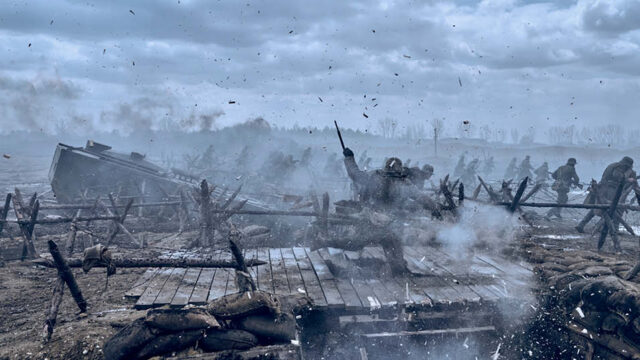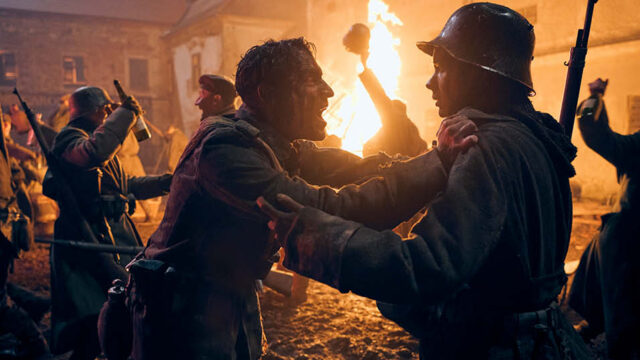Following its Bafta triumph, cinematographer James Friend ASC BSC and supervising colorist Andrew Daniel talk about Netflix’s ‘All Quiet on the Western Front.’
The film, directed by Edward Berger, which had its world premiere at the 2022 Toronto International Film Festival, is a powerful condemnation of warfare, depicting the physical, financial, and psychological toll that The Great War had on the German people.
Based on the book of the same name by Erich Maria Remarque, it takes inspiration from real-life events and figures and was originally adapted for the big screen in 1930 by Universal.
Produced by Amusement Park Film for Netflix, the first ever German-language adaption of Erich Maria Remarque’s book was lensed by James Friend ASC BSC with Universal Production Partners (UPP) delivering picture post, supported by senior colorist, Andrew Daniel, at Goldcrest Post.
“We implemented an ACEs color managed pipeline in DaVinci Resolve Studio to ensure a smooth transition between the conform, grade and finish,” explains UPP project coordinator, Jakub Brychta.
Daniel was flown into Prague to lead the grade alongside Czech post-production house UPP. “I was involved early on, designing a series of transform LUTs ahead of principal photography for use on set throughout the dailies process,” he explains. “We created just two in the end; one for day and another for the night.”
“Ed, James and I had previously worked together on ‘Patrick Melrose,’ so we quickly found the shorthand that had served us so well in that production.”
Along with Berger, the duo collaborated on a look that would carry the production reveals Daniel. “It’s a project with a legacy, both in literary and cinematic terms. As such, we were keen to move away from the more familiar looks that similar productions share, pushing the saturation and contrast. We also created a subtle grain structure to feed throughout.”
Every film is a process of discovery, reveals Friend. “I don’t know exactly how I want the film to look at the start of production. When the rushes start to come in, I gradually move in a direction that reflects the story’s integrity. With All Quiet, we wanted it to be naturalistic and feel raw. True to the environment and its historical context.”
The ARRI 65 was chosen as principal camera and supplemented by an Alexa Mini LF on a Stabileye. “Ed and I worked through the script to determine which aspects of the film would suit which camera,” notes Friend. “The 65 worked quite well in opening up confined spaces like the trenches to audiences for example.
A particular fan of using natural light, Friend worked closely with gaffa Daniel Kafka to enhance the films naturalism.
Friend’s drive for authenticity in the film stemmed from reading the novel as a schoolchild. He felt it was particularly poignant in today’s climate and showed the genuine emotions of war experienced through the eyes of young soldiers on the frontline.
“We wanted it to feel more like a documentary than a novel,” says Friend. “Naturally, we looked at other war films, mainly because of their sensory nature. For example, ‘Saving Private Ryan’ was a great source of inspiration. The anxiety levels you feel due to the combination of imagery and sound is incredible.”
James and Berger also worked closely with acclaimed costume designer Lisy Christl to replicate the uniforms’ colors accurately. “Lisy presented us with some uniforms from the period as inspiration,” Friend recalls. “And those became our starting point for the film’s color palette. Lisy and her team got to the point where you couldn’t tell the difference between the original uniforms and her costumes. She’s an absolute genius.”
In ensuring all of the details were as precise as possible, the film developed a strong sense of integrity and realism according to Friend. “We actually wanted the film to be quite colorful with this in mind,” he explains.
“You have an obscene amount of mud in the frame, camouflaged uniforms with earthy tones, and a lot of caucasian skin. This reflects the time, but equally, blood is red and the sky is sometimes blue. It’s not all sepia-toned and grey clouds. We wanted to bring these elements into the look too.”
Daniel and Friend also worked closely with Senior VFX Supervisor Frank Petzold throughout the grade, with progress shared openly to encourage collaboration and discussion. “He was in the room for the entirety of the grade, providing immediate feedback and progress updates. We would also spit ball ideas and problem solve in the grade,” says Daniel.
The film features in excess of 460 VFX shots, according to Petzold. “While the VFX vendors used more traditional platforms, I quickly discovered that there was a lot of last minute VFX that we could complete in DaVinci Resolve, whether that was mixing lock off’s, split screens or fixes,” he explains.
“Likewise, while Andrew was grading, I could quickly test an edit or comp on my laptop using the same Resolve project, which could then be implemented by Andrew.”
“For the tank-battle scenes, we also used the camera-shake tool a lot. Edward was able to see a preview on the laptop without cutting into Andrew’s grading time.”
Occasionally, VFX team had to produce multiple versions of each VFX shot, both with and without certain elements, allowing for a more targeted grade by Daniel. “One good example is where a tank emerges through the fog with the soldiers looking on from the trenches,” he explains.
“If you play with fog, it is very dependent on contrast, and we had to be able to adjust that interactively. So, we did multiple versions of the same shot with and without the tank and fog and put them into Resolve for live mixing during the color grade to control when you see the tank.”
The collaboration between the trio on-site at UPP in Prague and Petzold’s enthusiasm for attending the entire grade resulted in a nearly seamless post workflow.
“This, combined with the efficiency and execution of the finish with David Koubik and the UPP team, made the production a true pleasure to work on,” concludes Daniel. “It’s been a real passion project, and while it deals with some challenging themes and is quite raw, it does manage to illustrate the true nature and emotions of war beautifully.”
Pictures: ©Reiner Bajo
Jon Creamer
Share this story



















